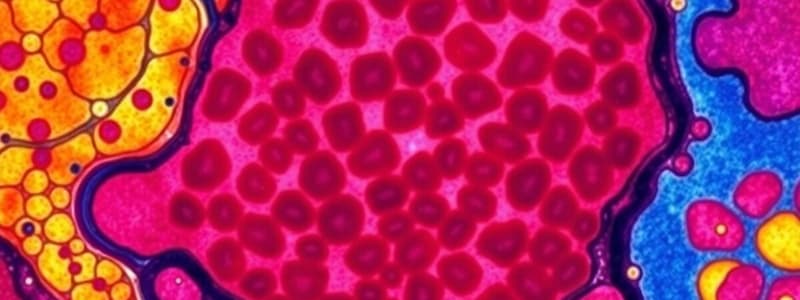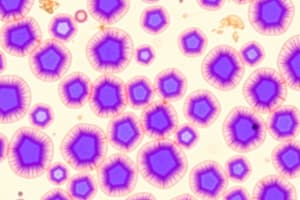Podcast
Questions and Answers
The type of epithelium that lines small excretory ducts in various organs and is involved in covering and secretion is known as simple ______ epithelium.
The type of epithelium that lines small excretory ducts in various organs and is involved in covering and secretion is known as simple ______ epithelium.
cuboidal
Epithelium found lining the upper respiratory passages, such as the trachea and bronchi, and characterized by cells that appear to be arranged in multiple layers but are not, is called ______ columnar epithelium.
Epithelium found lining the upper respiratory passages, such as the trachea and bronchi, and characterized by cells that appear to be arranged in multiple layers but are not, is called ______ columnar epithelium.
pseudostratified
The type of epithelium that is exclusively located in the excretory passages of the urinary system and can change shape in response to stretching is referred to as ______ epithelium.
The type of epithelium that is exclusively located in the excretory passages of the urinary system and can change shape in response to stretching is referred to as ______ epithelium.
transitional
A protective type of epithelium with multiple cell layers, where the basal cells are cuboidal or columnar and the surface cells are flattened, is identified as stratified ______ epithelium.
A protective type of epithelium with multiple cell layers, where the basal cells are cuboidal or columnar and the surface cells are flattened, is identified as stratified ______ epithelium.
The epithelium that lines the external surfaces of the body and contains non-living, keratinized surface cells is known as keratinized stratified ______ epithelium.
The epithelium that lines the external surfaces of the body and contains non-living, keratinized surface cells is known as keratinized stratified ______ epithelium.
In contrast to skin, the moist cavities like the mouth and esophagus are lined by nonkeratinized stratified ______ epithelium, which exhibits live surface cells.
In contrast to skin, the moist cavities like the mouth and esophagus are lined by nonkeratinized stratified ______ epithelium, which exhibits live surface cells.
The epithelium observed in the conjunctiva lining the eyelids, characterized by multiple layers of cells with the surface layer being columnar, is classified as stratified ______ epithelium.
The epithelium observed in the conjunctiva lining the eyelids, characterized by multiple layers of cells with the surface layer being columnar, is classified as stratified ______ epithelium.
The inner lining of blood vessels, known as ______, is composed of simple squamous epithelium, which facilitates rapid diffusion.
The inner lining of blood vessels, known as ______, is composed of simple squamous epithelium, which facilitates rapid diffusion.
The epithelium covering the digestive organs such as the stomach and intestines, which functions in lubrication, absorption, and secretion, is the simple ______ epithelium.
The epithelium covering the digestive organs such as the stomach and intestines, which functions in lubrication, absorption, and secretion, is the simple ______ epithelium.
Bowman's capsule in the kidney is lined by ______ squamous epithelium, which is adapted for filtration.
Bowman's capsule in the kidney is lined by ______ squamous epithelium, which is adapted for filtration.
Flashcards
Simple Squamous Epithelium
Simple Squamous Epithelium
Allows rapid diffusion across the epithelium; found in mesothelium and endothelium.
Simple Cuboidal Epithelium
Simple Cuboidal Epithelium
Lines small excretory ducts; involved in covering and secretion. Examples: thyroid, kidney tubules.
Simple Columnar Epithelium
Simple Columnar Epithelium
Covers digestive organs (stomach, intestines, gallbladder); functions in lubrication, absorption, protection, and secretion.
Pseudostratified Columnar Epithelium
Pseudostratified Columnar Epithelium
Signup and view all the flashcards
Transitional Epithelium
Transitional Epithelium
Signup and view all the flashcards
Stratified Squamous Epithelium
Stratified Squamous Epithelium
Signup and view all the flashcards
Stratified Squamous Nonkeratinized Epithelium
Stratified Squamous Nonkeratinized Epithelium
Signup and view all the flashcards
Stratified Squamous Keratinized Epithelium
Stratified Squamous Keratinized Epithelium
Signup and view all the flashcards
Stratified Cuboidal Epithelium
Stratified Cuboidal Epithelium
Signup and view all the flashcards
Stratified Columnar Epithelium
Stratified Columnar Epithelium
Signup and view all the flashcards
Study Notes
Epithelial Tissue
Simple Squamous Epithelium
- Includes the mesothelium and endothelium.
- Allows rapid diffusion across the epithelium.
- Mesothelium is the lining of vessels.
- Serous lining of cavities include the pericardium, pleura, and peritoneum (mesothelium).
- Lining of vessels is endothelium.
- Active transport by pinocytosis occurs in the mesothelium and endothelium.
- Secretion of biologically active molecules occurs in the mesothelium.
Simple Cuboidal Epithelium
- Lines small excretory ducts in different organs, covers, and secretes.
- The covering is located in the ovary and thyroid.
Simple Columnar Epithelium
- Covers the digestive organs including the stomach, small and large intestine, and gallbladder.
- Functions include lubrication, absorption, protection, and secretion.
- It may have apical microvilli or cilia.
- Microvilli are located in the intestines and gallbladder.
- Ciliated examples are the fallopian tube and uterus.
- Lines the intestine and gallbladder.
- Functions to provide protection, lubrication, absorption, and secretion.
Pseudostratified Columnar Epithelium
- Lines the upper respiratory passages, which are the trachea and bronchi.
- Also lines the lumina of the epididymis and vas deferens.
- Frequently ciliated and provides protection, transport, and secretion.
- Located in the lining of the trachea, bronchi, and nasal cavity.
- Functions in protection and secretion: cillia-mediated transport of particles trapped in mucous out of the air passages.
Transitional Epithelium
- Exclusively in the excretory passages of the urinary system.
- Covers lumina of renal calyces, pelvis, ureters, and bladder.
- The epithelium changes shape in response to stretching, fluid accumulation, or contraction during voiding of urine.
- Bladder, ureters, and renal calyces are lined with transitional epithelium.
- Provides protection and distensibility.
Stratified Squamous Epithelium
- Consists of multiple cell layers.
- Basal cells range from cuboidal to columnar while surface cells become squamous.
- Functions for protection.
- Includes nonkeratinized and keratinized types.
Stratified Squamous Nonkeratinized Epithelium
- Exhibits live surface cells.
- Covers moist cavities like the mouth, pharynx, esophagus, vagina, and anal canal.
Stratified Squamous Keratinized Epithelium
- Lines external surfaces of the body.
- Contains non-living surface keratinized cells, like skin.
Stratified Cuboidal Epithelium
- Has limited distribution.
- Lines larger excretory ducts of salivary and sweat glands.
- Located in sweat glands and developing ovarian follicles.
- Functions in protection and secretion.
Stratified Columnar Epithelium
- Distribution is limited.
- Observed in the conjunctiva lining the eyelids
- Located in the conjunctiva.
- Provides protection.
Specific Locations
- Kidney tubules have simple cuboidal epithelium.
- Bowman's capsule has simple squamous epithelium.
- Thyroid follicles exhibit simple cuboidal epithelium.
- Ileum has simple columnar epithelium with microvilli and goblet cells.
- Jejunum has simple columnar epithelium with microvilli and goblet cells.
- Trachea has ciliated pseudostratified columnar epithelium with goblet cells.
- Olfactory epithelium has ciliated pseudostratified columnar epithelium.
- Epididymis has pseudostratified columnar epithelium with stereocilia.
- Esophagus has non-keratinized stratified squamous epithelium.
- Vagina has non-keratinized stratified squamous epithelium.
- Thick skin on the palm has keratinized stratified squamous epithelium.
Studying That Suits You
Use AI to generate personalized quizzes and flashcards to suit your learning preferences.




